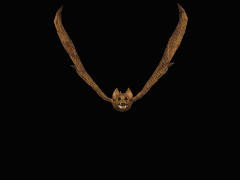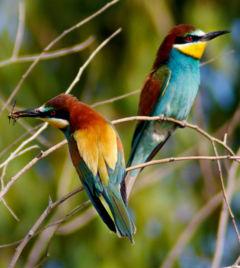


|
Meropidae:
The bee-eaters are a group of near passerine birds in the family Meropidae. Most species are found in Africa but others occur in southern Europe, Madagascar, Australia and New Guinea. They are characterised by richly coloured plumage, slender bodies and usually elongated central tail feathers. All are colorful and have long downturned bills and pointed wings, which give them a swallow-like appearance when seen from afar.
Just as the expressive name reveals, bee-eaters predominantly eat insects, especially bees, wasps and hornets, which are caught in the air by sallies from an open perch. While they will pursue any type of flying insect, honeybees predominate in their diet. The world range of the bee-eaters is nearly identical to the native world range of the four species of honeybees. Fry et al. (1992) say that "in 20 separate studies of the diet of 16 kinds of bee-eaters, Hymenoptera (ants, bees and wasps) comprised from 20% to 96% of all insects eaten, and honeybees formed on average about one-third of the Hymenoptera." Catching an insect mid-air is referred to as sallying. Before eating its meal, a bee-eater removes the sting by repeatedly hitting the insect on a hard surface. During this process, pressure is applied to the insect thereby extracting most of the venom. Once an insect lands the bee-eater ignores it, even if in plain sight. Bee-eaters are programmed to catch things only on the wing. Bee-eaters are gregarious. They form colonies by nesting in burrows tunneled into the side of sandy banks, such as those which have collapsed on the edges of rivers. Their eggs are white and they generally produce 2-9 eggs per clutch (depending on species), which are widely distributed and common. As they live in colonies, large numbers of these holes are often seen together, white streaks from their accumulated droppings accentuating the entrances to the nests. Most of the species in the family are monogamous, and have biparental care of the young. |
